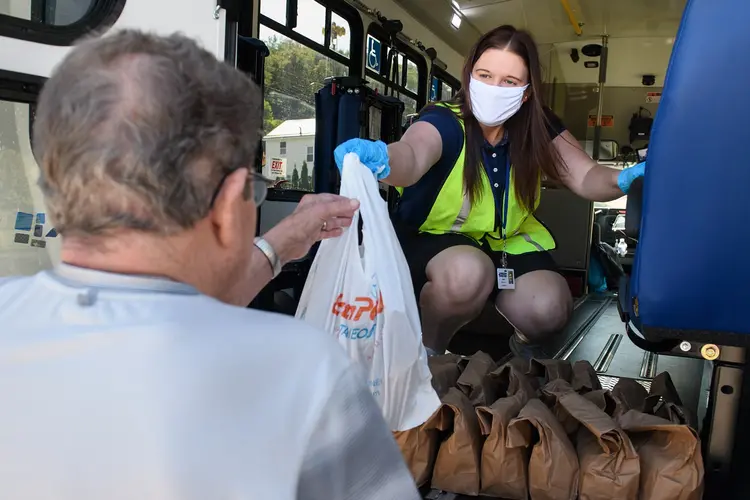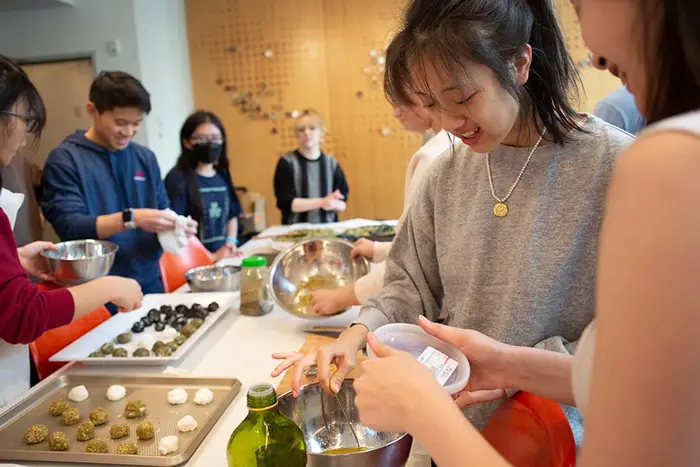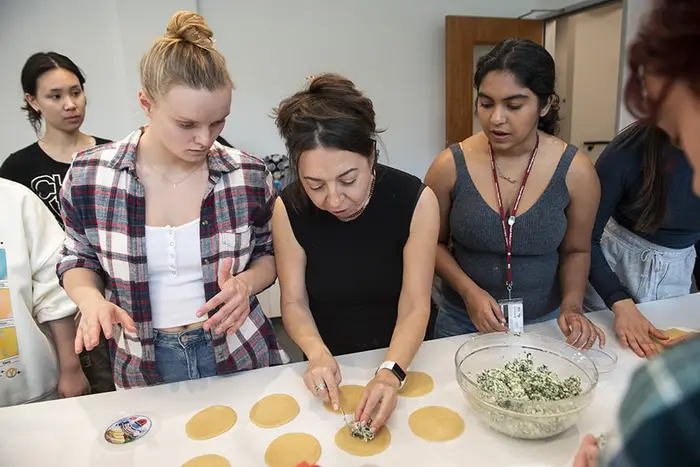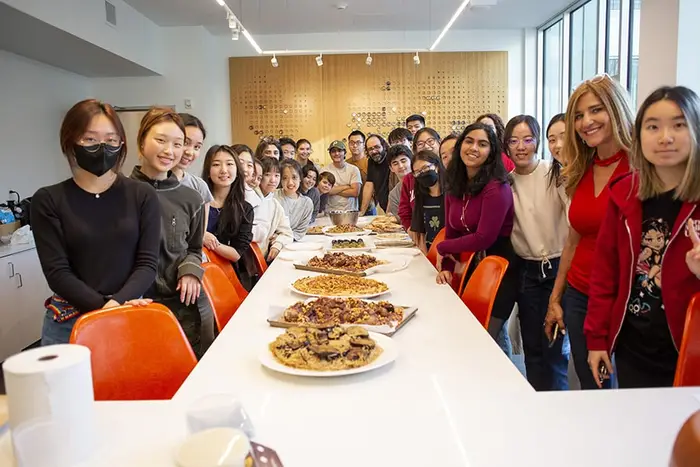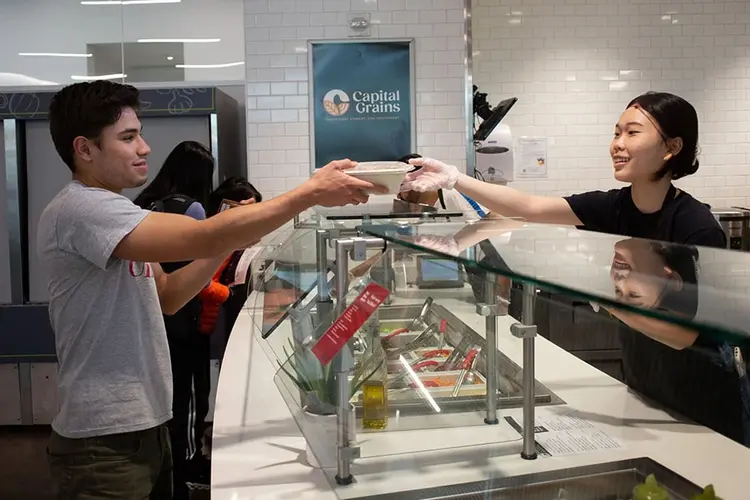A Recipe for Understanding
Grand Challenge Seminar students explore history and culture through food
Media Inquiries
"Food is not neutral.It is a very rich and deep way of looking at Palestinian and Israeli identity and history." — Michal Friedman
The long, bright kitchen bustles with noise and activity: Onions are chopped into fine crescents, piled into a pot and spiced with purple grains of sumac; labaneh, a creamy strained yogurt, is rolled into balls and dusted with green zaatar spice and small black nigella seeds; chicken poaches on a stove with bay leaf and cardamom. Monitoring it all is Chef Fadi Kattan. He strides between the cooks, checking their work, instructing as necessary.
This is not the back end of a restaurant. This is the first-floor kitchen of Carnegie Mellon University's Fifth and Clyde Residence Hall, and the cooks are first-year students enrolled in the Dietrich College of Humanities and Social Sciences(opens in new window)' Palestinian and Israeli Food Cultures Grand Challenge Seminar(opens in new window).
Co-taught by Michal Friedman(opens in new window), the Jack Buncher Professor of Jewish Studies in the Department of History, and Nevine Abraham(opens in new window), an assistant teaching professor of Arabic studies in the Department of Modern Languages, the class filters Palestinian and Israeli history, culture and conflict through the lens of food. Topics range from regional and culinary history, to gender roles in Israeli and Palestinian communities, to the ways displacement and military occupation affect agriculture.
Working with chefs and food scholars is a vital ingredient. This year's guests were Michal Nahman, a scholar and cook of Canadian-Israeli heritage whose Mizrachi Food Project traces the anthropology of food specific to Middle Eastern and North African Jewish people, and Kattan, a Franco-Palestinian chef from Bethlehem whose new London restaurant, Akub, serves traditional Palestinian dishes with an innovative twist.
Kattan demonstrates how to mix a freekeh salad. See Kattan's recipes(opens in new window)
Food is Not Neutral
Israel/Palestine is a deeply fraught region with a complicated history and culture — when there is so much to say, why focus on food?
"Food is not neutral," Friedman said. "It is a very rich and deep way of looking at Palestinian and Israeli identity and history."
From ingredients to origins to ownership, food can help decode the complexities of a region.
"We look at ... how communities blend and impact each other and reshape their understanding of food and identity," Abraham said.
Friedman and Abraham prepare students before the chefs visit campus. Drafting questions ahead of time helps build students' confidence and enables them to broach potentially sensitive or controversial topics in ways that are productive and nuanced.
And, of course, there is the cooking.
As the first guest on campus, Nahman worked with the students to make bourekas, a Sephardi baked hand pie stuffed with cheese and spinach and topped with sesame seeds; fried eggplant served with tahini and pomegranate seeds; and saut�ed tomatoes with garlic, cilantro, sea salt and chili flakes. The students also competed in a savory/sweet board challenge, during which they had to race to create the most appealing labaneh or tahina board using traditional Middle Eastern ingredients.
Nahman shows students how to fill bourekas. See Nahman's recipes(opens in new window)
Learning from Each Other
Friedman and Abraham's strong rapport and intellectual partnership is evident from the moment the two step into a room. Although they were relative strangers specializing in different fields, after meeting in 2019 they quickly agreed on how to structure the course.
Friedman brings her knowledge of history, going back to the Middle Ages, moving into the migration of Jews across Europe, and finally the modern history of the Arab-Israeli conflict, to the course. Abraham provides the cultural and literary perspective, introducing novels and memoirs that help students understand the Arab and Jewish diasporas and how they contributed to today's culinary culture. The two are at work on a research paper together.
"We are always learning from each other," Abraham said.
The professors' parallel experiences growing up in the Middle East also lend an extra layer of nuance to the course. Abraham grew up in Egypt, Friedman in Israel, and the two experienced historical events, including the peace treaty signed between Egypt and Israel in 1979, in ways that both intersected and diverged. They bring these personal experiences into the classroom, explaining how pivotal moments were understood by people living through them, on different sides of a border.
"It was important for us, on a topic that's so fraught, that we have a Jewish and an Arab voice coteaching," Friedman said. "It's more powerful and more meaningful for students to have two instructors (from different backgrounds)."
Students also appreciate this diversity of experience.
"Grand Challenge Seminars are valuable because they give you different perspectives on issues that sometimes it feels like society is afraid of talking about," said Warisha Khan, a first-year student studying at CMU's Institute for Politics and Strategy(opens in new window).
Fellow student Elizabeth McBride, a first-year student in the Department of History(opens in new window), welcomed the opportunity to learn about a topic not often taught in U.S. high schools.
"As an American student, I never really had any knowledge of Palestinian history before the creation of Israel in 1948," McBride said.
From left to right: Friedman, Kattan and Abraham.
Students pose with the food they've prepared.�
Kitchen As Classroom
The students finish preparing Kattan's menu and set it on serving platters on the long kitchen island: maqloubeh, lamb layered with eggplant, tomato and rice; musakhan, chicken on flatbread topped with caramelized onions and toasted pine nuts; labaneh balls rolled in spices; freekeh salad filled with herbs and pomegranate seeds; and silky homemade hummus studded with chickpeas, slivered almonds and lemony sumac.
They dig in, scooping up food with flatbread. The room swells with laugher and chatting, the atmosphere easy and happy. For all the course's intensive and challenging subject matter, in this moment, everyone is experiencing the same thing: the chance to eat and talk, the special satisfaction that a good meal can offer.
— Related Content —
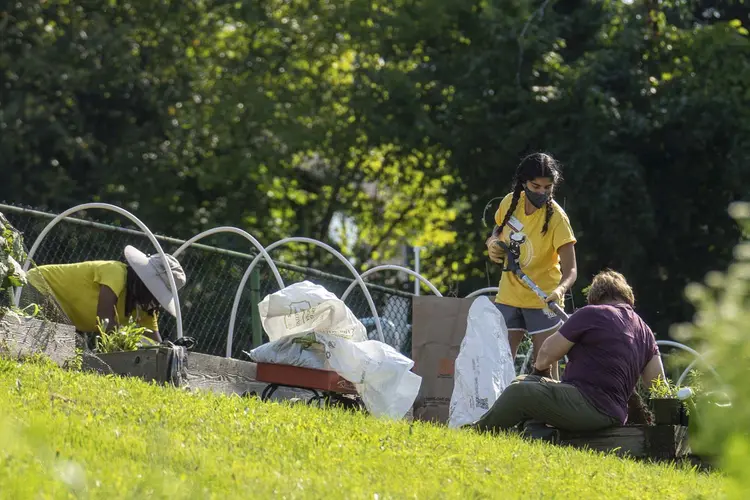
Orientation Day of Service Instills Sense of Community
